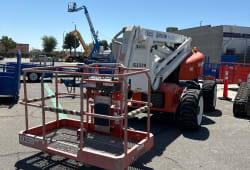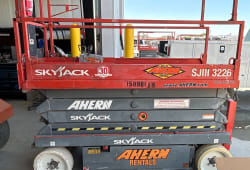Mastering The World of Motor Graders: Understanding Components & Functions
9 Min read
)
January 27, 2024
Motor graders, often referred to as "graders," are heavy equipment machines essential for shaping and levelling surfaces. These robust machines play a crucial role in construction and road maintenance projects. In this complete guide, we'll delve into the world of motor graders, exploring their functions, components, and the key role they play in creating smooth and even surfaces for various applications.
Understanding Motor Graders
These grades are specific types of construction equipment designed for particular tasks. They come equipped with a lengthy, flat blade that serves various purposes, including grading, levelling, and spreading materials. The main goal of them is to achieve a consistent and uniform distribution of materials like soil or gravel, resulting in a smooth and even surface.
These machines find widespread use in the construction and upkeep of roads, highways, and other infrastructure projects. Their specialized design and functionality make them essential for creating surfaces that meet specific standards and requirements. They play a crucial role in shaping terrains, ensuring that the ground is level and properly graded to support the construction and maintenance of various structures and transportation routes.
Key Components of Motor Graders
1. Blade
A motor grader is a heavy-duty construction machine, and its primary working part is called the blade. The blade is a large, flat piece of metal that can be adjusted to different angles and heights. The main purpose of the blade is to cut through materials, like soil or gravel, and then move or spread them to achieve a specific surface finish.
Think of the blade as a big, adjustable shovel attached to the motor grader. It plays a crucial role in shaping and levelling the ground, whether it's a construction site or a road. By adjusting the angle and height of the blade, operators can control how much material is cut and where it is deposited.
This process helps create a smooth and even surface, meeting the desired specifications or grade for the construction project. So, in essence, the blade is essential for achieving the right terrain or road smoothness and grade.
2. Frame
The frame of a motor grader is a vital component as it plays an important role in providing essential structural support for the entire vehicle. Think of it as the backbone of the motor grader, responsible for maintaining stability and strength, particularly when dealing with heavy workloads and demanding tasks.
The primary function of the frame is to bear substantial loads and endure harsh operating conditions. To put it simply, it acts as the foundation that ensures the motor grader remains sturdy and steady when performing challenging operations.
3. Wheels
They are heavy equipment commonly used in construction projects to shape and level terrain. They are equipped with six wheels, a feature that greatly enhances their manoeuvrability on construction sites. These wheels are essential for the grader's mobility, enabling it to navigate effectively through different types of terrain encountered in construction work. The number of wheels is a crucial factor influencing the overall performance of the grader.
It directly affects the machine's ability to move efficiently and carry out tasks such as leveling the ground, grading surfaces, and shaping the terrain according to the project requirements. In summary, the six wheels of a motor grader contribute significantly to its capability to operate effectively and perform various tasks on construction sites.
4. Cab
The operator's cab is the designated area where the key actions take place for operating the grader. This enclosed space serves as the control centre, allowing the operator to manage the grader's movements, make adjustments to the blade, and oversee the entire grading process. In essence, it is the central location from which the operator orchestrates and directs the various functions of the grader, essentially making it the focal point where the operational "magic" occurs.
Functions of Motor Graders
Cutting and Shaping
They excel in cutting and shaping surfaces, ensuring that the terrain meets the specified grades and slopes required for construction projects. These grades excel in cutting and shaping surfaces, making sure that the terrain meets the specified grades and slopes required for construction projects.
Let's break down the 2 key tasks:
Cutting Surfaces
When we mention that these grades excel in cutting surfaces, it refers to their ability to remove or adjust the existing terrain. This cutting process is crucial in achieving the desired elevation or slope for construction projects.
Imagine a construction site with uneven or rough ground. They can effectively cut through this terrain, removing excess soil or material to create a more even and level surface.
Shaping Surfaces
Shaping surfaces involves moulding the terrain to meet specific grades and slopes as required by a construction project's design. This is where the precision and versatility of these grades come into play.
The motor grader's blade, a large flat piece of metal, can be adjusted to different angles and heights. This allows the operator to shape the terrain according to the specifications outlined in the construction plans.
Whether it's forming the base for a road, a foundation for a building, or any other construction project, the motor grader makes sure that the surface is precisely shaped to meet the engineering requirements.
Fine Grading
These machines are adept at fine grading, a process essential for creating smooth and level surfaces. In the context mentioned, such machines play a crucial role in road construction. Fine grading refers to the precise adjustment of the ground surface to meet specific elevation and smoothness requirements.
The precision of these machines is vital for achieving a surface that is not only level but also smooth. In road construction, having a smooth and level surface is important for several reasons.
First, it enhances safety by minimizing unevenness or abrupt changes in the road, which can reduce the risk of accidents and improve overall road stability. Second, it contributes to driving comfort, ensuring a smoother and more enjoyable ride for vehicles and passengers.
Spreading Materials
They are essential machines in construction that play a crucial role in evenly distributing various materials across construction sites. These materials can include soil, gravel, or other aggregates. The primary purpose of them is to make sure that these materials are spread uniformly, creating a consistent and level surface.
This even distribution is vital for establishing a solid foundation, which is essential for the stability and durability of structures built on the construction site. In summary, they contribute significantly to the construction process by promoting a uniform distribution of materials, ultimately laying the groundwork for a strong and stable foundation.
Snow Removal
In areas where winters are severe, they are commonly fitted with additional tools such as snowploughs. This modification enables them to effectively remove snow from roads and parking lots, thereby improving access and making it easier for people to travel and use these spaces.
Essentially, the added snowplough attachments enhance the ability of these grades to keep roads and parking areas clear during snowy and icy conditions, ensuring better mobility and convenience for the local community.
Creating Drainage Slopes
They play a crucial role in creating slopes that aid in effective drainage. When roads or surfaces are constructed, it's essential to ensure proper water runoff to prevent issues like water accumulation and erosion. Imagine a road without proper drainage – during rainfall, water could pool on the surface, leading to potential hazards for drivers and causing wear and tear on the road.
The adjustable blade of a motor grader allows operators to shape the surface with a slight slope. This slope is strategically designed to guide water away from the road or infrastructure. As rainwater falls, it naturally follows the slope and drains away from the road surface. This controlled drainage is vital because it prevents water from collecting and stagnating on the road, reducing the risk of damage.
Additionally, effective drainage helps in preventing erosion. Erosion occurs when water wears away the soil or surface material over time. Without proper drainage slopes, rainwater can erode the sides of roads or other structures, compromising their stability. By using motor graders to create well-designed slopes, the risk of erosion is significantly reduced, contributing to the longevity and durability of roads and infrastructure.
Challenges and Solutions
Motor graders, essential in construction, encounter obstacles like steep terrain and harsh weather. To overcome these challenges, manufacturers constantly innovate by introducing features such as all-wheel drive and advanced blade control systems.
These enhancements aim to improve the graders' overall performance and efficiency in navigating difficult landscapes and adverse weather conditions. All-wheel drive provides better traction, allowing graders to move more effectively on steep or uneven surfaces.
Advanced blade control systems enable operators to precisely adjust the grading equipment, ensuring accuracy and optimal results even in challenging environments. This dedication to innovation makes sure that they remain versatile and effective tools in the ever-evolving field of construction.
Conclusion
They are unsung heroes in the construction and maintenance of our infrastructure. Their ability to shape, grade, and level surfaces with precision makes them indispensable in creating safe and reliable transportation routes. As technology advances, we can expect them to become even more efficient, contributing to the development of robust and resilient infrastructure worldwide.
Explore the latest advancements in motor graders and stay informed about how these machines are shaping the future of construction. Whether you're involved in the industry or simply curious about the machinery that builds our roads, staying updated ensures you're part of the journey toward safer and more reliable infrastructure.

Caleb Woods is an experienced content specialist and an editor at Boom & Bucket, blending his journalism background with expertise in the heavy equipment industry. He delivers engaging, informative content to help professionals stay informed and make smarter decisions in the machinery market.











